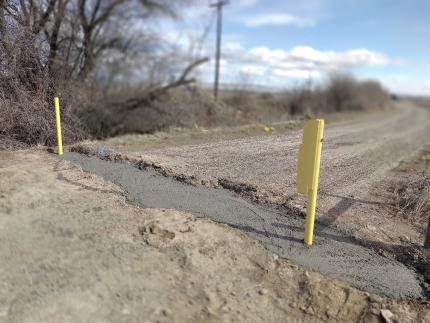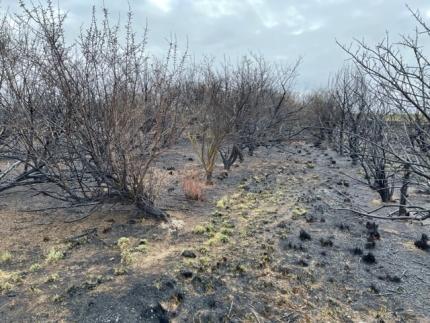Managing Wildlife Populations
Ground Squirrel Surveys: Assistant District Biologist Wampole commenced Townsend ground squirrel (Urocitellus townsendii townsendii) surveys in Kittitas and Yakima counties. Surveys conducted in 2020 and 2021 confirmed a significant decline in Townsend ground squirrel occupancy at historic colony sites. Current surveys aim to monitor remaining occupied sites and identify new colony locations.

Ground Squirrel Surveys: District 4 Wildlife Biologist Fidorra revisited Townsends ground squirrel colonies for the range wide survey of this Washington endemic species. Thus far two of 27 Benton County colonies that were active in 2005 had squirrels detected. There was a sharp decline in occupancy around the year 2018.
Tricolored Blackbird Research: District 4 Wildlife Biologist Fidorra placed sound recorder devices at two known tricolored blackbird colonies for a California researcher. The loggers will be used to analyze vocalizations but also provide remote monitoring for arrival and productivity which is valuable for this rare breeding species in Washington.
Providing Recreation Opportunities
Hardy Canyon Gate Installation: The Wenas Wildlife Area staff members installed a gate near the Hardy Canyon trailhead to allow both users on foot and those on horseback to access the Hoover acquisition. The sale for this property recently went through. The property will be a walk-in only access site for the public. Opportunities for wildlife viewing, hunting, and hiking will be popular throughout the new acquisition. The primary focus of this acquisition is to conserve shrubsteppe and riparian habitat.

Wenas Wildlife Area Road Maintenance: Manager Hughes and Assistant Manager Taylor have been working closely with Capital Asset Management Program (CAMP) on road maintenance being conducted on the Wenas. The three priority roads being worked on through June are Kelly Hollow leading into Hessler Flats and Bell Tell off Sheep Company and Roza roads. The roadcrew is becoming familiar with the alkali and clay soils throughout the Wenas along with spring runoff issues that occur when there are not proper drainages built into each road. Taylor and Hughes have been working with the roadcrew on getting rolling dips and ditch outs to be angled enough for water to run off the road. If there is not enough angle (aiming for a 45-degree angle) the water will pool at the base of each rolling dip in the road. Another important feature is making the rolling dips wide enough and gradual so you can easily roll through while driving compared to a drastic dip that is difficult to haul a trailer through or get a fire engine through. Certain parts of the road are also being out sloped for water runoff. Almost all the roads throughout the Wenas have severe damage due to spring run-off issues. It is very exciting, there was some funding allowing maintenance work and some issues to be addressed. In the long run, the road maintenance will help keep user groups on the established road and in turn preserve adjacent habitat that was being eroded due to spring run off and from the public driving off the main road in order to get through.

Providing Conflict Prevention and Education
Mule Deer and Highways: Washington Department of Fish and Wildlife staff members met with Washington State Department of Transportation (WSDOT) to discuss a potential point of collaboration to reduce vehicle collisions with wildlife on major roadways in Kittitas County. Information obtained from GPS collared mule deer highlighted key corridors of movement which will help guide WSDOT project priority and mitigation efforts by establishing hotspots of possible conflict.
Oak Creek Volunteers and Visitor’s Center Banquet: Oak Creek Manager Mackey and Assistant Manager Charlet attended the annual volunteer awards dinner in Yakima. Two 20-year service awards, one 10-year service award, one 5-year service award, one “Smooth Talker” award, and one “Busy Bee” award were handed out to honor our dedicated volunteers for the year.
Conserving Natural Landscapes
2022 Vantage Highway Fire: Assistant Manager Winegeart and Natural Resource Specialist Nass established photo points in a 100 acre section of the Vantage Highway Fire footprint which is planned for drill seeding in the fall. Later, they joined a Washington Department of Fish and Wildlife archaeologist and volunteering foresters in performing a pedestrian cultural survey of the same area. The entire 100 acres was also aerially treated with Laramie 25DF to control cheatgrass for fall seeding in some areas and to control cheatgrass to reduce native grass competition as the plants recover from fire in others.


Roza Fence Posts and Cable: Assistant Manager Taylor and Natural Resource Technician Stoltenow pounded metal posts with a cable strung across to prevent unauthorized vehicle access in the Roza portion of the wildlife area. An area was left open adjacent to the gate for the public to be able to walk in or ride a horse in. The following weekend someone from the public went even further off the Green Dot Road to cut a fence the wildlife area installed behind the cable and drove their motorized vehicles through. This has been an ongoing challenge for the Wenas Wildlife Area. The surrounding landscape of the area is difficult to block off where the Green Dot Road ends. Below the Green Dot Road goes into a riparian area along with heavier fuels. This is a popular area for hunting, wildlife viewing, and hiking. It also holds valuable habitat for elk, upland birds, mule deer, and more. Manager Hughes is going to continue to work with enforcement on the illegal offroad use past the gate and fenced area.


Wenas Kelly Hollow Reseeding: Habitat Specialist Miller seeded old, decommissioned sections of Kelly Hollow Road, as well as new ditch-outs on the Kelly Hollow and Hessler Flat roads. This seeding will be the start to recovering habitat from an outdated and unusable roadbed.
Wenas Sheep Company Spraying: Habitat Specialist Miller made a spray application at the Shooting Range off of Sheep Company Road. This spray will help to ensure the berms are acting as sufficient fire breaks as well as making the shooting area a pleasant and accessible place to recreate for the public. This will help to limit dispersed shooting on the wildlife area, benefiting public safety as well as limiting distribution of refuse.
Sunnyside/Snake River Spraying: Approximately 480 acres of the recently burned Byron Unit was sprayed for annual grasses by helicopter in preparation for seeding of native vegetation in the fall.

Solar Energy Project Reviews: District 4 Wildlife Biologist Fidorra attended meetings and reviews of several solar projects in District 4. The scope and size of projects overall will have unmitigated impacts to many wildlife species.
Providing Education and Outreach
Arbor Day Event: Assistant Manager Winegeart assisted with Arbor Fest at the Yakima Arboretum.

Other
Sunnyside-Snake River Wildlife Area: With the weather improving slightly in recent days, Natural Resource Technician Wascisin and Assistant Manager Ferguson spent several days pulling up and burning last year’s bumper crop of kochia and Russian thistle from around the shop and office area at the Sunnyside Unit. They also put pre-emergent herbicide down to hopefully curb growth of the weeds this year.

Assistant Manager Ferguson has been busy installing the new gate for the driveway to the Sunnyside Unit office. The gate structure is made of heavy-gauge steel and composed of a swinging gateway and a frame situated underground and embedded in ten yards of concrete. The hope is to prevent any further forced entries into the compound by burglars.


Sunnyside Unit Front Gate: Assistant Manager Ferguson completed installation of the new front gate at the Sunnyside Unit.



Region 3 Chainsaw Training: Sunnyside-Snake River Wildlife Area Manager Kaelber, Sunnyside Assistant Manager Jahns, Sunnyside Natural Resource Technician Manderbach, Oak Creek Wildlife Area Manager Mackey, L.T. Murray Assistant Manager Winegeart, Natural Resource Specialists Blore, Nass, Frame, and Stoltenow attended chainsaw training in Yakima. The training was provided by members of the Department of Natural Resources Ahtanum Wild Land Fire Hand Crew. It was a fun training, and we learned a ton of valuable information!
Clark Pond Fire: On Wednesday, Mar. 22, there was a fire in the Clark Pond Unit of the Sunnyside-Snake River Wildlife Area. The fire began on neighboring private property and spread into the wildlife area, burning an estimated 87 acres. Unfortunately, all the native shrub plots in the unit were destroyed.


Region 3 Fall Protection Training: Sunnyside Manager Kaelber, Sunnyside Assistant Manager Jahns, all L.T. Murray Wildlife Area staff members, and all Oak Creek Wildlife Area staff members attended Fall Protection Awareness training at the regional office in Yakima.